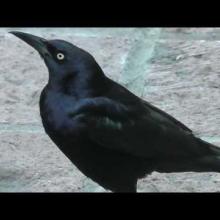

Join BirdNote tomorrow, November 30th!
Illustrator David Sibley and actor H. Jon Benjamin will face off in the bird illustration battle of the century during BirdNote's Year-end Celebration and Auction!
Ranging from metallic hisses to electronic yodels, sounds of grackles may not be music to our ears—but they have their own rough beauty, a distinctive, primal harshness. Grackle songs evolved to carry through their nesting habitats — dense marshes and brushy landscapes — where more lyrical notes and phrases wouldn’t carry well. However strange they may sound, they know how to make themselves heard.
BirdNote®
The Harsh Beauty of Grackle Songs
Written by Bob Sundstrom
This is BirdNote.
[https://macaulaylibrary.org/asset/61224, 13-17.]
The sounds of grackles may not be music to our ears—but they sure do get your attention. And they have their own rough beauty, a distinctive, primal harshness.
[https://macaulaylibrary.org/asset/61224, 13-17.]
Male grackles sing to attract mates and ward off rivals. However strange to our ear, their songs work well.
Grackles are oversized blackbirds. Of three grackle species in North America, the Common Grackle of the eastern states has the simplest song, with metallic hisses and raspy quavers:
[https://macaulaylibrary.org/asset/61224, 13-17.]
And a mob of foot-long males in the same tree make an otherworldly racket:
[https://macaulaylibrary.org/asset/89567741, .08-.13]
The 16-inch Great-tailed Grackle of the Southwest sings the most complex grackle song, a symphony of squeaky hinges, explosions of static, and electronic yodels.
[Great-tailed: https://macaulaylibrary.org/asset/213743, 5-7 + 16-18 + 31-36–use all in order]
So… why do they sound so harsh and jangly? Grackle songs evolved to carry through their nesting habitats — dense marshes and brushy landscapes — where more lyrical notes and phrases wouldn’t carry well.
(Common Grackle ML92475641 P Marvin)
Grackles may not be the most... melodious singers, but they sure know how to make themselves heard.
(Common Grackle ML92475641 P Marvin)
For BirdNote, I’m Mary McCann.
###
Senior Producer: John Kessler
Production Manager: Allison Wilson
Producer: Mark Bramhill
Associate Producer: Ellen Blackstone
Bird sounds provided by The Macaulay Library of Natural Sounds at the Cornell Lab of Ornithology, Ithaca, New York. Common Grackle ML61224 recorded by WWH Gunn, Common Grackle ML89567741 recorded by R Sanderson, Great-tailed Grackle ML213743 recorded by B McGuire, Common Grackle ML92475641 recorded by P Marvin
BirdNote’s theme was composed and played by Nancy Rumbel and John Kessler.
© 2021 BirdNote May 2021 / August 2023
Narrator: Mary McCann
ID# sound-28-2021-5-13 sound-28




